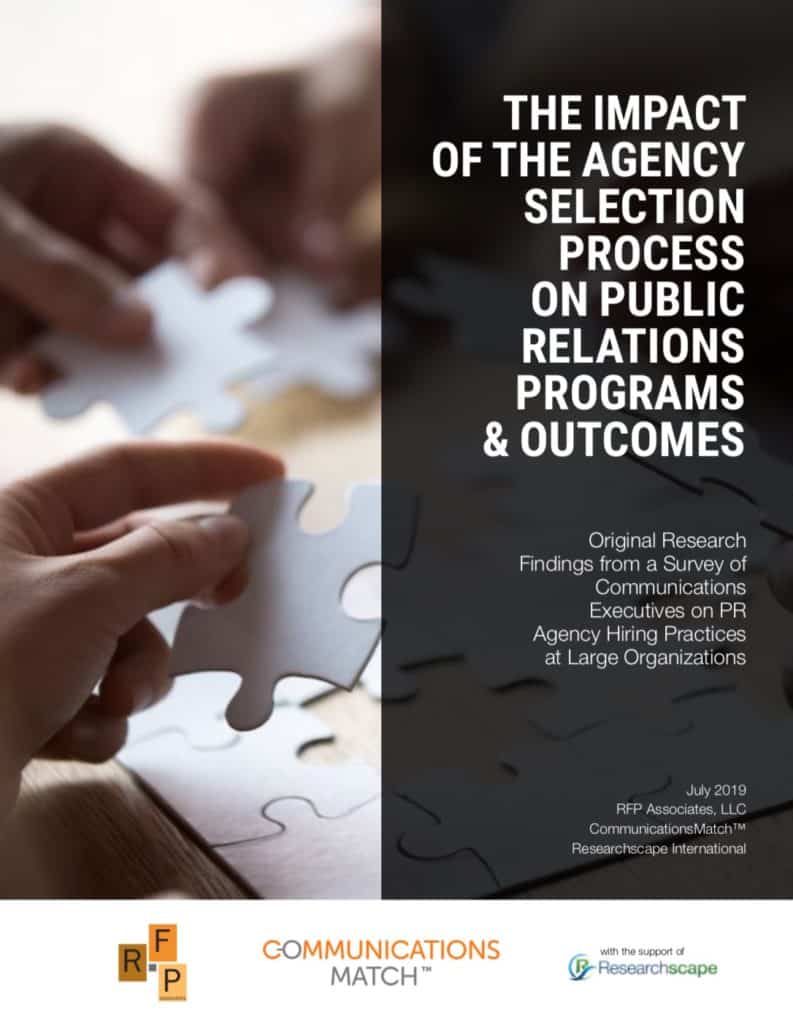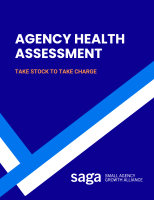New research from RFP Associates and CommunicationsMatch with support from Researchscape and the Institute for Public Relations delivers valuable perspectives on how agencies should look at business development and client retention.
The survey of senior communications executives at mostly large organizations — half work at publicly-traded companies and 25% spend more than $1 million per year on PR firms — uncovers important drivers of the agency-client relationship, including how business leaders make their choices. The study focused on PR agencies, but many of the same lessons can be extrapolated more broadly.
Let’s examine some of the findings and what they mean for PR and marketing agency owners.
1 out of 3 clients are not very satisfied with their agencies
Just 65% of the respondents described themselves as “very” or “completely” satisfied with their primary PR agency.
From a retention standpoint, that’s a pretty big red flag for agencies. It behooves agency leaders to work hard to uncover their clients’ true level of satisfaction.
At the same time, that lack of satisfaction creates an opportunity for competing agencies. It’s always easier to get business from a business who already employs an agency because it means they have the budget and mindset to work with agency partners.
Top client complaints focus on account management
About two-thirds of clients feel their agencies aren’t proactive enough and half harbor concerns about account coordination and oversight. Nearly as many cite issues with meeting objectives and staying within budget.
While the study doesn’t dive in to the underlying cause of these concerns, the results suggest that the day-to-day team leads may lack the experience or strategic capabilities that the agency originally used to win the business.
Agencies must be careful to ensure that the client service component of engagements matches the expectations set during the pitching phase. Leaving junior team members in charge of daily client work could lead to issues down the road.
Staff turnover concerns clients
Just under half of respondents expressed concern about staff turnover at the agencies they hire. It’s no secret to any agency leader that retention represents and ongoing concern in-house, but it is also being noticed by the folks who pay the bills.
This finding underscores the need for agencies to invest in their teams and focus on how to improve retention. At the same time, efforts must be undertaken to ensure smooth transitions when departures inevitably occur. Establishing and documenting clear processes for team members can help ensure client expectations continue to be met.
Most clients don’t search very thoroughly for new agencies
Two-thirds of business leaders rely on their peers or other word-of-mouth suggestions for agencies to consider. A very small minority — less than 15% — do their own research or turn to outside media, directories, or consultants for advice.
That means that agencies need to work hard to get the word out about their firms to prospective clients before a search begins. Identifying potential good fits and ensuring that you’re on their radar screens will in advance represent the best way to have the opportunity to win a seat at the table.
Typical agency searches don’t involve many competitors
Just two to five agencies receive consideration during the selection process, according to 64% of survey participants. When coupled with the finding that word-of-mouth is the biggest way to identify candidates, this further highlights the need to aggressively work to get in front of the right prospects.
Agencies that sit back and wait for their phones to ring will be at a huge disadvantage.
Executives with agency experience are much less likely to be satisfied with the search process
It should come as no surprise that those with knowledge of what goes on behind the curtain have the lowest level of satisfaction with how agency selections are made.
Knowing as much as you can about the backgrounds of the key decision-makers matters in all business development efforts, but it is particularly important to know if they have sat in your seat as an agency leader.
When your prospect knows how the sausage is made, you must keep that in mind and actively combat the notion that you’re up to any “typical” agency tricks in the process.
Prospects withhold vital information from agencies in the RFP process
The study acknowledges that most agencies don’t like the RFP process. I often describe it as a sometimes necessary evil that should be avoided when possible. But it isn’t always possible or prudent to ignore RFP’s entirely.
When clients keep secret information that would help in producing better RFP responses, it shouldn’t be surprising that agencies don’t like it.
The study found that clients openly admit that their RFP’s omit key facts:
- 71% don’t include any proprietary information
- 46% don’t give budget guidance
- 44% don’t share selection criteria
- 34% don’t disclose the decision timeline
- 20% don’t identify goals and objectives for the work
Without that sort of critical information, it can be quite difficult to produce a viable response.
To combat this lack of information, agencies should be using the Q&A process available in many RFP processes or leveraging preexisting relationships with the prospect to fill in the gaps.
If you can’t get the necessary information, it may be better to take a pass and invest your business development time and resources elsewhere.
Agencies often ignore the RFP guidelines
Many agencies believe they can — and should — venture outside the lines of the RFP to propose solutions that they believe are the best fit for the client. Sometimes that works, but the survey results seems to suggest that more often it does not.
Among the concerns that executives cited in RFP responses from agencies, the following topped the list:
- 40% turned in boilerplate responses
- 35% tried to upsell from the RFP specifications
- 21% were off target in their respnses
- 17% missed the budget mark
- 14% didn’t differentiate themselves
- 13% lacked relevant experience
Agency leaders should look at RFP processes quite critically and only participate in those that actually represent a good fit. Phoning it in or attempting to get the client to go for a different approach are more likely to reflect poorly on the agency in the long-term than win business in the near-term.
Additional Resources
- View the full report (PDF)
- View the press release (PDF)
- Listen to Robert Udowitz and Steve Drake of RFP Associates discuss the RFP process on the Chats with Chip podcast
- Listen to Chip Griffin and Gini Dietrich discuss the pros and cons of the RFP process on the Agency Leadership Podcast











